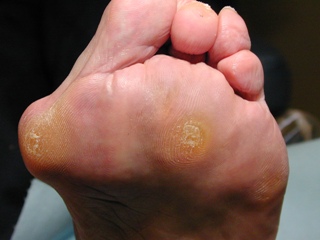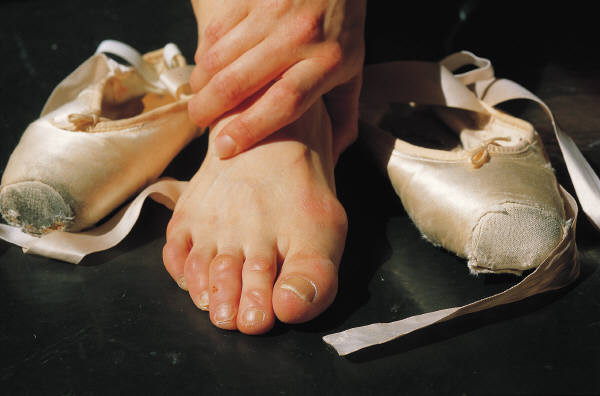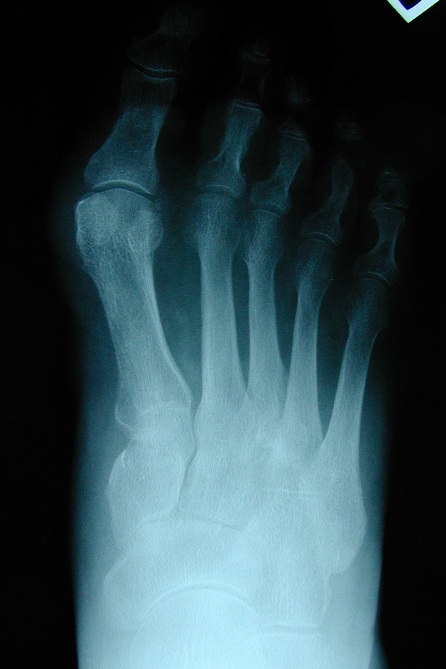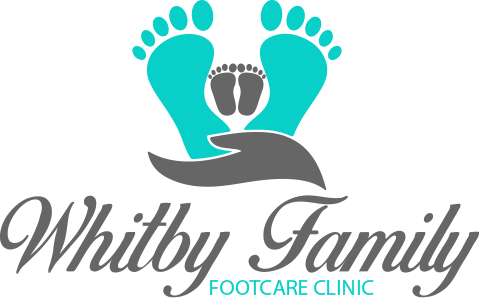HAV can develop as a result of an inherited structural defect or stress on your foot or due to a medical condition such as arthritis. If there is an underlying structural defect in your foot this can lead to compensations causing stresses and pressures to be applied unevenly on the joints and tendons in your feet. This imbalance in pressure and stress makes your big toe joint unstable. Over time this causes the medial side of the 1st metatarsal head to develop excess bone that protrudes out beyond the normal shape of your foot.
The size of the bunion can get larger over time which causes further crowding your other toes and causing pain. Pain from a bunion can be severe enough to keep you from walking comfortably in normal shoes. The condition may become painful as the bump gets worse, and extra bone and a fluid-filled sac (bursa) grow at the base of the big toe. By pushing your big toe inward, a bunion can squeeze your other toes into abnormal positions. This crowding can cause the four smaller toes to become bent or a claw-like in shape. These bent toes are known as hammertoes.
Smaller bunions called “bunionettes” can also develop on the joint of your 5th toe.
Causes of HAV
 People born with abnormal bones (congenital) in their feet.
People born with abnormal bones (congenital) in their feet.- Inherited foot type
- Foot injuries
- Inflammatory or degenerative arthritis causing the protective cartilage that covers your big toe joint to deteriorate.
Risk factors for HAV
 Wearing high heels forces your toes into the front of your shoes, often crowding your toes.
Wearing high heels forces your toes into the front of your shoes, often crowding your toes.- Wearing shoes that are too tight, too narrow or too pointed are more susceptible to bunions.
- Pain from arthritis may change the way you walk, making you more susceptible to bunions.
- Occupation that puts extra stress on your feet or job that requires you to wear ill-fitting shoes
- The tendency to develop bunions may be present because of an inherited structural foot defect.
Symptoms of HAV
- A bulging bump on the outside of the base of your big toe.
- Swelling, redness or soreness around your big toe joint aggravated by footwear.
- Red, calloused skin along the inside edge of the big toe.
- Corns or calluses under the ball of the foot or where the first and second toes overlap.
- Persistent or intermittent pain.
- Restricted movement of your big toe.
Diagnosis
 Your family doctor or chiropodist /podiatrist can identify a bunion simply by examining your foot. During the exam, your big toe will be moved up and down to determine if your range of motion is limited. You will be examined for signs of redness or swelling and be questioned about your history of pain. A foot x-ray can show an abnormal angle between the big toe and the foot. In some cases, arthritis may also be seen. A X-ray of your foot may help identify the cause of the bunion and rate its severity
Your family doctor or chiropodist /podiatrist can identify a bunion simply by examining your foot. During the exam, your big toe will be moved up and down to determine if your range of motion is limited. You will be examined for signs of redness or swelling and be questioned about your history of pain. A foot x-ray can show an abnormal angle between the big toe and the foot. In some cases, arthritis may also be seen. A X-ray of your foot may help identify the cause of the bunion and rate its severity
Treatments
Bunions can develop at any time. Although bunions often require no medical treatment you should consult your family doctor/chiropodist/podiatrist. Treatment options vary depending on the severity of your bunion and the amount of pain it causes you. Although they don’t always cause problems, bunions are permanent unless surgically corrected. If the cushioning sac of fluid (bursa) over the affected joint becomes inflamed (bursitis), a bunion can be very painful and interfere with your normal activities. Bunions may get larger and more painful, making nonsurgical treatment less effective.
Self-treatment
- Apply a non-medicated bunion pad around the bony bump.
- If a bunion becomes inflamed or painful, apply an ice pack two to three times daily to help reduce swelling.
- Wear shoes with a wide and deep toe box.
- Avoid shoes with heels higher than 2 inches (5.1 centimeters).
Nonsurgical treatment:
- Changing your footwear to roomy and comfortable shoes that provide plenty of space for your toes.
- Padding and taping applied by chiropodist/podiatrist to your foot can reduce stress on the bunion and alleviate your pain.
- Oral medications such as acetaminophen (Tylenol), ibuprofen (Advil, Motrin) or naproxen (Aleve) may help control the pain of a bunion.
- Cortisone injections.
- Over-the-counter arch supports can help distribute pressure evenly when you move your feet, reducing your symptoms and preventing your bunion from getting worse.
- Prescription foot orthotic devices to help stabilize the forefoot.
- Manual foot therapy to free up motion in arthritic foot joints
Surgical Treatment
Surgery isn’t recommended unless a bunion causes you frequent pain or interferes with your daily activities. If conservative treatment doesn’t provide relief from your symptoms, you may need surgery. There are many different types of surgical procedures for bunions, and no particular bunion procedure is best for every problem. If the bunion gets worse and more painful, surgery to realign the toe and remove the bony bump (bunionectomy) can be effective.
Most surgical procedures include a bunionectomy, which involves:
- Removing the swollen tissue from around your big toe joint
- Straightening your big toe by removing part of the bone
- Realignment of the 1st metatarsal bone to straighten out the abnormal angle in your big toe joint
- Permanently joining the bones the 1st metatarsophalangeal joint
It’s possible you may be able to walk on your foot immediately after a bunion procedure. However, full recovery can take up to eight weeks or longer with some bunion procedures.
To prevent a recurrence, you’ll need to wear proper shoes and a foot orthotic after recovery.
No surgical procedure is without risk and you may still have pain or you could develop a new bunion in your big toe joint after surgery.
